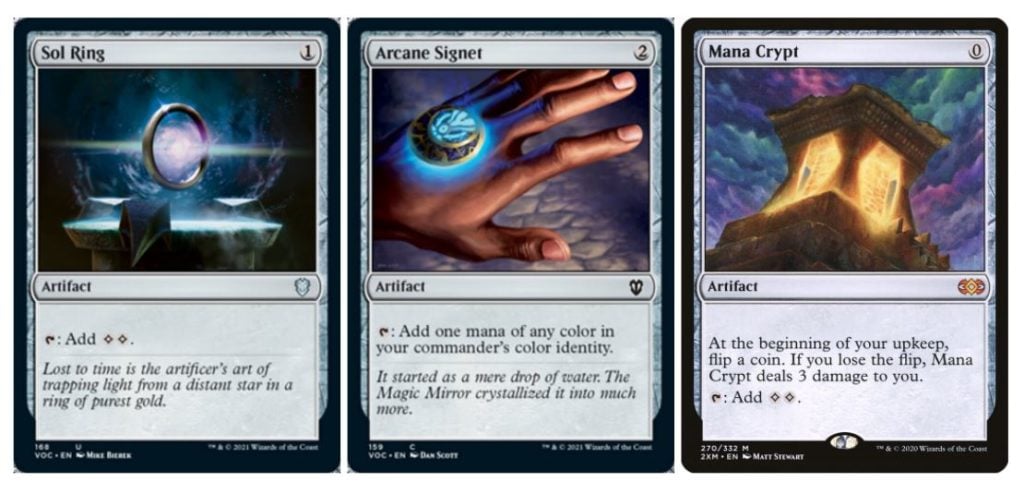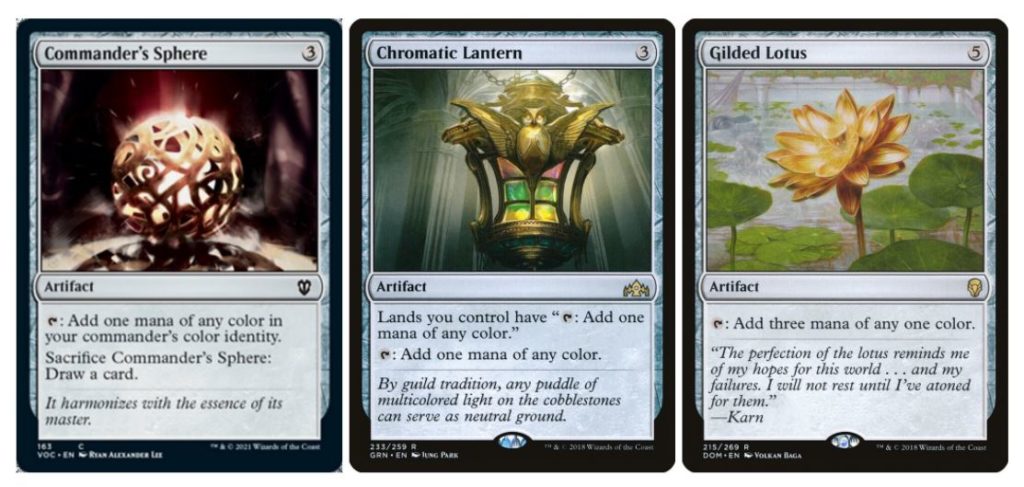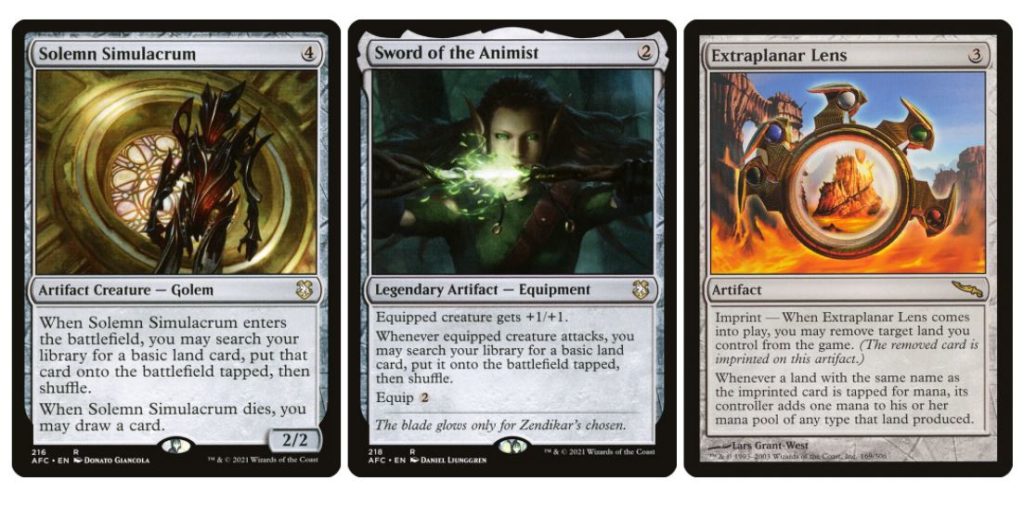Commander is a special format; it plays like no other, and has very different heuristics compared to any other way to play. One such heuristic is that virtually every deck needs ramp; without it, you’ll easily fall behind as the table progresses. Most Commander decks can go over the top of everyone else, but they need a way to ensure they can enact their plans.
But what is “ramp”? MTG Wiki defines ramp as “A card which accelerates your mana, giving you an additional, reusable mana source beyond the usual one land per turn. Examples include mana dorks, mana rocks, and spells which allow you to put extra lands into play beyond the one-per-turn limit.”
The right ramp for you will depend entirely on your deck; what’s right for one deck may not work well for another, so it’s important to get it right to make sure your deck plays smoothly. I’m going to cover all of the main categories of ramp in Commander, and where each one may be useful.
The Classics

Some ramp spells see more play than most, and they’re generally seen as “auto-includes” in most decks. Sol Ring and Arcane Signet are included in every preconstructed deck now, and will almost certainly improve any deck. Some players dislike them for their ubiquity, and others aren’t fond of how much they’re above the usual rate, but there’s no denying their strengths. They are cheap and efficient, and Sol Ring even nets you mana the turn you play it.
When you’re playing above low-to-mid power, these mana rocks start to feel like more of a requirement than an option. While they are fairly affordable, thanks to a number of reprints, it is still worth noting that they’re not necessary in most decks. They are powerful, however, and will almost always improve a deck’s performance.
When talking about higher power levels, I’d be remiss to omit Mana Crypt. This rock is usually a sign that you’re playing at a much higher power level, and is generally reserved for the most tuned lists. It’s also quite expensive, so you’ll only really need it if you’re looking to play closer to cEDH.
Green Ramp Spells
Green is the color of ramp. It can provide acceleration in almost any way possible, and is generally revered for its ability to do so.

Rampant Growth is one of the classic green ramp spells; in fact, it’s the card that gave “ramp” its name! For two mana, you can grab a land from your deck and put it into play; that’s the gold standard by which all ramp spells are measured. Cultivate and Skyshroud Claim are more expensive options that provide additional value, all of which are found in abundance in Commander.
If you’re more creature-focused, then mana dorks may be more to your liking. Llanowar Elves is the quintessential mana dork; one mana for a creature that taps for one mana is the baseline you’d generally expect. They may be cheaper to cast than the likes of Rampant Growth, but they’re much more susceptible to removal. A single board wipe would not only reset the battlefield, but remove all of your acceleration. It’s usually worth it, but it’s an important consideration.
A safer way to increase mana for cheap is through land Auras. They’re usually fairly efficient, like Utopia Sprawl or Wild Growth, and aren’t as susceptible to removal as mana dorks. They do, however, leave you open to getting blown out through land hate like Ghost Quarter, so be careful when putting multiple Auras on one land!

If you’re playing a deck that wants to make multiple land drops in a turn, there are several options available to you. Dryad of the Ilysian Grove, Exploration, and Wayward Swordtooth are ideal for the role; they’ll help trigger landfall effects multiple times in a turn while increasing your on-board land count. If you’re really looking to go hard on land drops, Azusa, Lost but Seeking is the right card for you.
Cards like Lotus Cobra and Tireless Provisioner may not be traditional ramp spells, but they serve a similar purpose in decks that want them. They generate mana through land drops, which is something you want to do every turn, anyway. You’ll usually want these for land-heavy decks, and decks that use land ramp as their primary source of acceleration.
There are some creatures that function as land ramp, too. Fertilid, Wood Elves, and Springbloom Druid all fetch lands out of your deck, just like Rampant Growth, but you can flicker or “reset” them for additional value. Fertilid is best for decks with +1/+1 counter synergies, and the others are great in Blink decks.
Mana Rocks
When you’re not playing green, you’re probably playing mana rocks. The usual rate for a mana rock is a two- or three-mana artifact that taps for one mana, though there are some exceptions. There are far too many to mention here, as most sets contain at least a few rocks, but I’ll cover the most popular and useful ones.

If you’re running two or more colors, you should look for the appropriate Signets first and foremost. They don’t technically make mana by themselves, as they require mana to be filtered through them, but that doesn’t stop them from being exceptional. They’re some of the most popular mana rocks, and for good reason: they’re efficient, they give you two colors, and they don’t cost you any life to use.
Once you’ve added the appropriate Signets to your deck, Talismans should be next on the list. Just like the Signets, all ten color pairs are available, and they cost just two mana to cast. Unlike the Signets, they can tap for either colored or colorless mana, but the former comes at the cost of life. It may not seem like much of a downside in a 40 life format, but the damage can add up over time, especially if you have multiple Talismans in play. You should definitely consider them for your decks, but just be aware of the damage you take over the course of your games.
Fellwar Stone can easily be one of the best rocks in the format, but it’s entirely dependent on what your opponents are playing. It’s generally better in decks with more colors, but it’s still an efficient and effective option for two-color decks.

If a mana rock costs three mana or more, it needs to tap for more than one mana or provide additional utility. Commander’s Sphere is generally considered the baseline: it only taps for one mana, but it’s one mana of any of your deck’s colors, and you can always sacrifice it to draw a card. Like Sol Ring and Arcane Signet, this shows up in most preconstructed decks, and is a perfectly serviceable form of ramp.
If you’re building a deck with heavy colored mana requirements, you’ll almost certainly benefit from Chromatic Lantern. With this on board, you’ll never have fixing issues ever again! This does make Chromatic Lantern a prime target for artifact removal, however, so bear that in mind when you’re playing.
For five mana, you’d expect a rock to do something spectacular, right? To be fair, Gilded Lotus is fairly fantastic. It’s a nod to the (in)famous Black Lotus, but in a more balanced and reusable form. This can give you a solid burst of mana, and it’s great for trying to pull ahead of the table. It sees a lot of play, and it’s even used in combos as a flicker target!
White Catch-up Ramp
White has gotten a lot of “catch-up” mechanics in recent years, with catch-up ramp being one of the most impactful. This is where you’re given the ability to accelerate your mana, but only to help you keep up with the players that are furthest ahead. It’s conditional, often based on whether opponents have more lands than you do, and won’t work if you’re ahead of them in that regard.

Knight of the White Orchid was once a Standard all-star, but has now found a forever home in white Commander decks. It’s pretty common to play this on turn three before you play your land for the turn to ensure it works, and it can contribute a fair bit of damage in the early turns, too. This is best in decks that can flicker it, but it’ll fit in almost any white deck just fine.
Keeper of the Accord is one of the better catch-up cards of the past few years. It not only ensures you have enough lands, but it also helps develop your board. It’s great at smoothing out your game plan on multiple axes, and should be added to almost any deck that can house it.
Archaeomancer’s Map isn’t quite Burgeoning or Land Tax, but it is a somewhat fixed version of both. This not only guarantees you hit your next few land drops, but also keeps you from falling behind. Unless you’re also running green, this should probably be in your white decks.
The Rest
There are some ramp cards that don’t quite fit the other categories, but deserve a mention nonetheless. Some of these are wildly popular, and can be powerhouses in the right build.

Solemn Simulacrum is another poster child of Commander, and it’s seen extensive play throughout the format’s lifespan. Four mana may seem like a high price for a basic land, but the sad robot really excels in providing utility. You can block with it, flicker it, or sacrifice it, and you’ll get a card when it dies. This should be one of the first ramp considerations in almost every deck, because of the flexibility it provides.
If you want to turn creatures sideways while accelerating, then Sword of the Animist might be the perfect tool for the job. Combat-focused players will regularly play it, advancing the game through damage while also working toward the late game. If you’re looking for a budget-friendly alternative, Explorer’s Scope is a great option for land-heavy decks, especially when paired with anything that can manipulate the top of the deck.
If you’re playing a monocolor deck with a lot of basics, Extraplanar Lens is amazing. It’s a symmetrical effect, however, but you can get around that by running snow-covered basics: they have a different name to their non-Snow counterparts, so only the snow-covered versions will benefit. Caged Sun is an alternative if you’d rather not fork out for the Extraplanar Lens, or even if you want multiples of the effect!
As you can see, there are countless ways to ramp in Commander, and each of these cards is unique enough to warrant consideration. I hope this has helped to break down the different options available, and made things a little clearer for your current decks or future builds.
What’s your favorite way to ramp? Do you have any preferences or “auto-includes” when it comes to mana acceleration? I’d love to know your thoughts on this, so feel free to chat with me about it on Twitter. Happy brewing!

Scott is an Irish content creator and the Head of Budget Magic for the Izzet League. He focuses on affordable decks in Pioneer, Modern, and Pauper, particularly ones that stray from the mainstream. When he’s not writing about his favorite decks, he can be found talking incessantly about them on Twitter and on The Budget Magic Cast.

